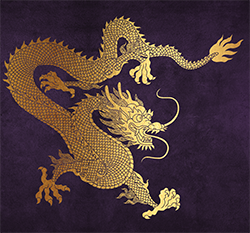The Forbidden City:
Inside the Court of China’s Emperors
Vancouver Art Gallery
Until Jan. 11
Reviewed by Annabel Howard
The Forbidden City was – states the Vancouver Art Gallery’s eponymous exhibition – the largest palace ever built. It covered 178 hectares, and to walk from the southern to the northern gates took one and a half hours. Not that its principal inhabitant – the Emperor – would ever have done that: he was, after all, never seen to walk in public. Instead, a bevy of eunuchs (the only other men allowed inside those hallowed walls), carried him aloft in a sedan chair. To ensure the delineation of status was clear, the chair passed over an untouched path paved with dragon-carved marble. No-one ever walked on these pavings – the dragon was the symbol of the Emperor, exclusively. The eunuchs walked to the side, on plain stone. This is but one insight into the life at the palace offered by the VAG’s Forbidden City. It serves to illustrate the fact that every movement and gesture, every material object, everything the Emperor ever touched, looked at, wore or displayed, was carefully orchestrated to demonstrate one thing: his power.
It is an extraordinary and brilliant act of diplomacy for Canada to gain access to the material of the Forbidden City, which represents one of the great strands of China’s cultural heritage, and which is carefully monitored by the Chinese government. Eighty works on display in this exhibition have never left the Forbidden City, let alone China, and many of the paper works in Vancouver were not shown in Toronto (where the exhibition was hosted at the ROM) because they were deemed too fragile.
It is, however, the highly diplomatic nature of this show that casts a strange shadow. The extent to which The Forbidden City has been subjected to political and economic ends is disarming, if not outright disturbing. In preparation for the launch, much was made of the unique cultural ties between China and Canada. At the Vancouver preview Kathleen Bartels, VAG director, took the opportunity to announce the opening of a new Institute of Asian Arts. It was perhaps no surprise that media attention focused on the presence of Christy Clarke, Mayor Gregor Robertson, various Chinese businessmen and Chinook Energy, trumpeting the “strong economic links” between the two countries, rather than focusing on the art itself.
Despite providing a tantalizing glimpse into the wealth and majesty of the Forbidden City, the quality of the exhibits was uneven, and at times felt sparse, and an attempt to organize the objects into a progression from pubic to private left many of the more interesting pieces grouped together in the final rooms.
Pure curiosity was satisfied by the opportunity to see an Imperial dog coat stitched in lilac silk, an Imperial latticed picnic basket, the Emperor’s bath, jade chop-sticks, a tea-cup made of gold and pearls and used only once a year, and a creatively styled air-conditioner that functioned with ice hewn from the mountains outside Beijing.
An insight into the life of the Emperor’s consorts is equally fascinating: hairpins made with Kingfisher feathers, platform sandals, 15 centimetre long nail guards decorated with precious stones and pearls, a robe so intricate it required the hands of 450 workers and, representing the root of it all – a mirror decorated with 100 boys at play, so the women wouldn’t ever forget why they was there.
It requires a bit more work to find the objects with intrinsic art historical value. Some of the Emperor Qianlong’s (r. 1735-1796) antique bronze collection is on display: a Song dynasty bell, commissioned by Emperor Huizong in 336 C.E. is one of only 30 that survive globally. A miniature porcelain cup, made between 1465 and 1487 is extremely rare and of exquisite quality. A fan painting of an Autumn Forest by Shen Zhou belongs to the literati movement – a highly refined, educated and expressionistic aesthetic well represented in this piece.
But throughout the exhibition notable gaps emerged, and these curatorial silences were not restricted to the material selection. There was no mention of the more than half a million original objects that are now displayed in the National Palace Museum, Taipei – the result of the Chinese Civil War. There was no mention of Tiananmen Square which lies just steps from the Forbidden City itself. There was no mention of Ai Wei Wei or the suppression of contemporary Chinese art. This seems a particularly glaring omission for a gallery that has hosted 28 shows of Asian art in 30 years, and is currently hosting Unscrolled: Reframing Tradition in Chinese Art.
It seems that this exhibition ultimately sacrificed cultural elevation for the chance to publicly promote economic links between China and Canada. Although the curators have created an appealing and approachable insight into 500 years of Imperial power, authority and excess, it is hard to view this as an exhibition of indubitable depth and quality.
Annabel Howard is a writer and art historian from the UK. Her art criticism has appeared in Glass Magazine, The World of Interiors, and National Geographic Travel.

{ 0 comments… add one now }